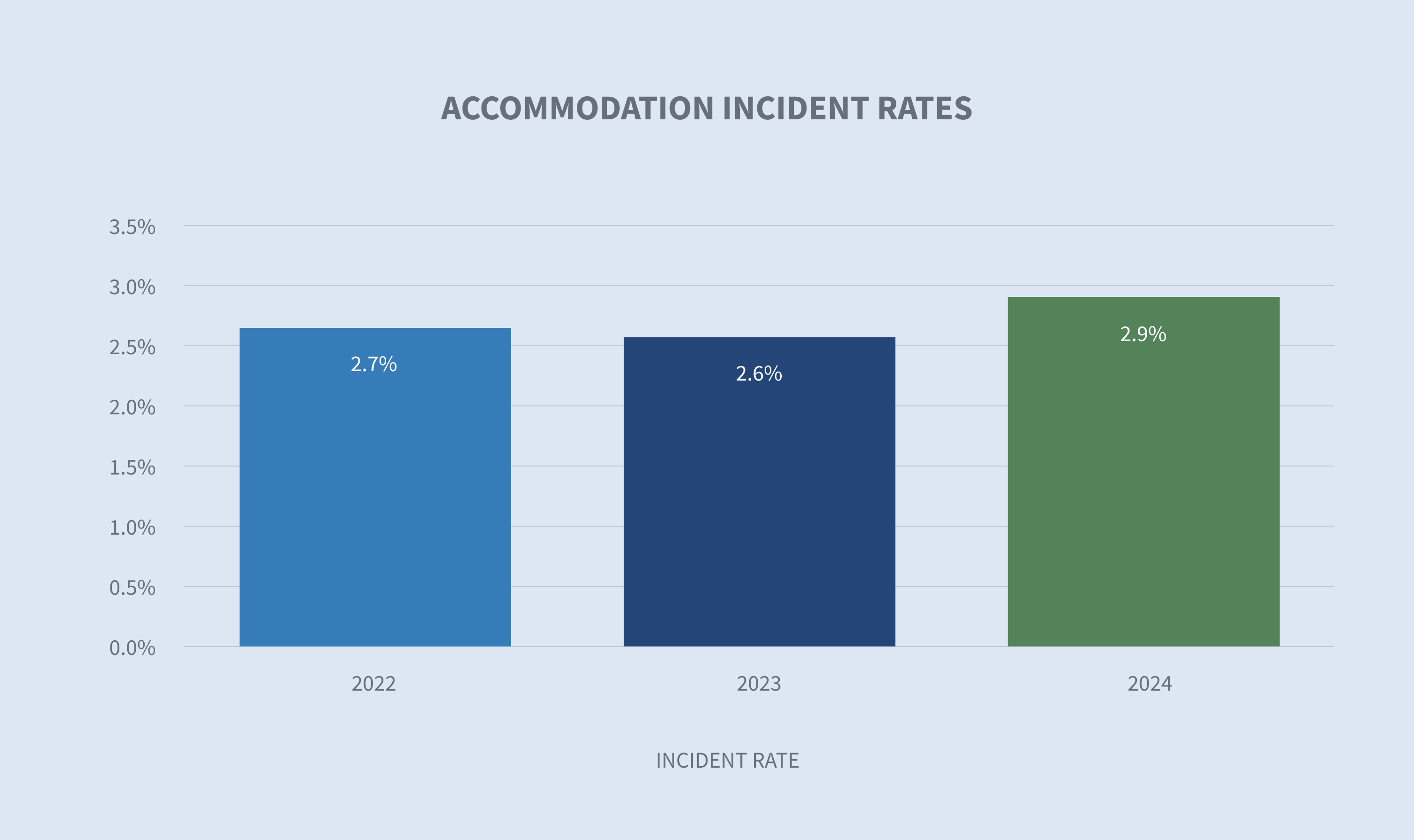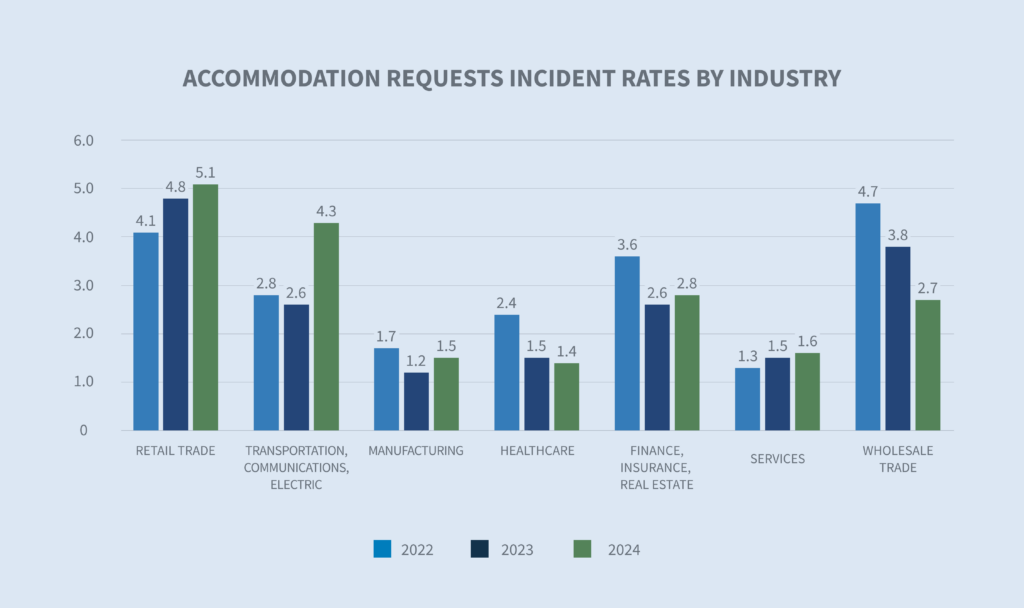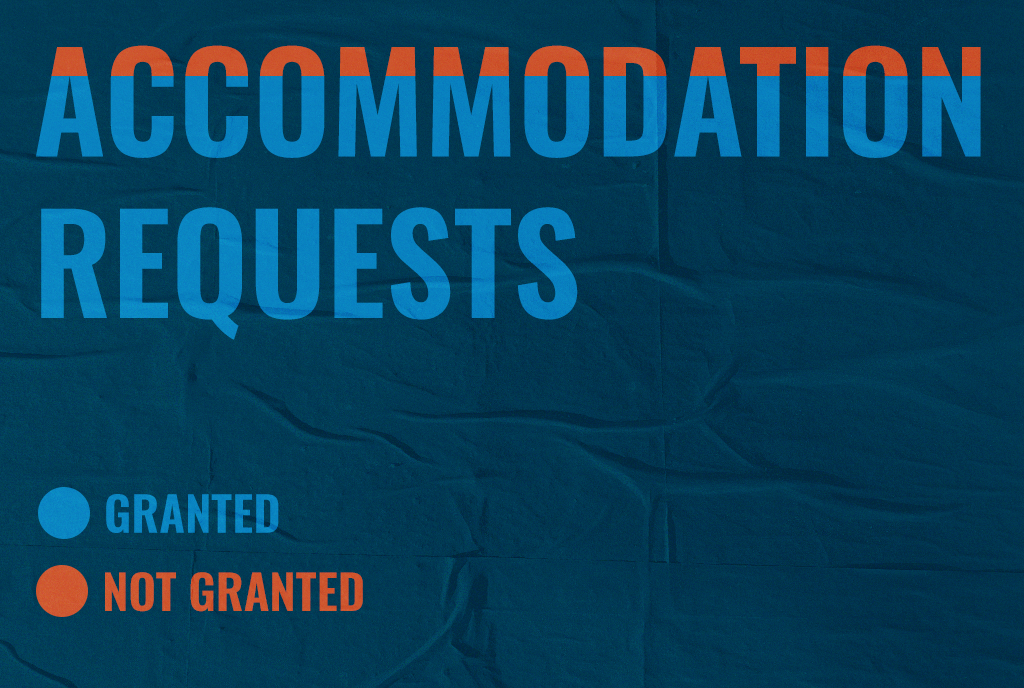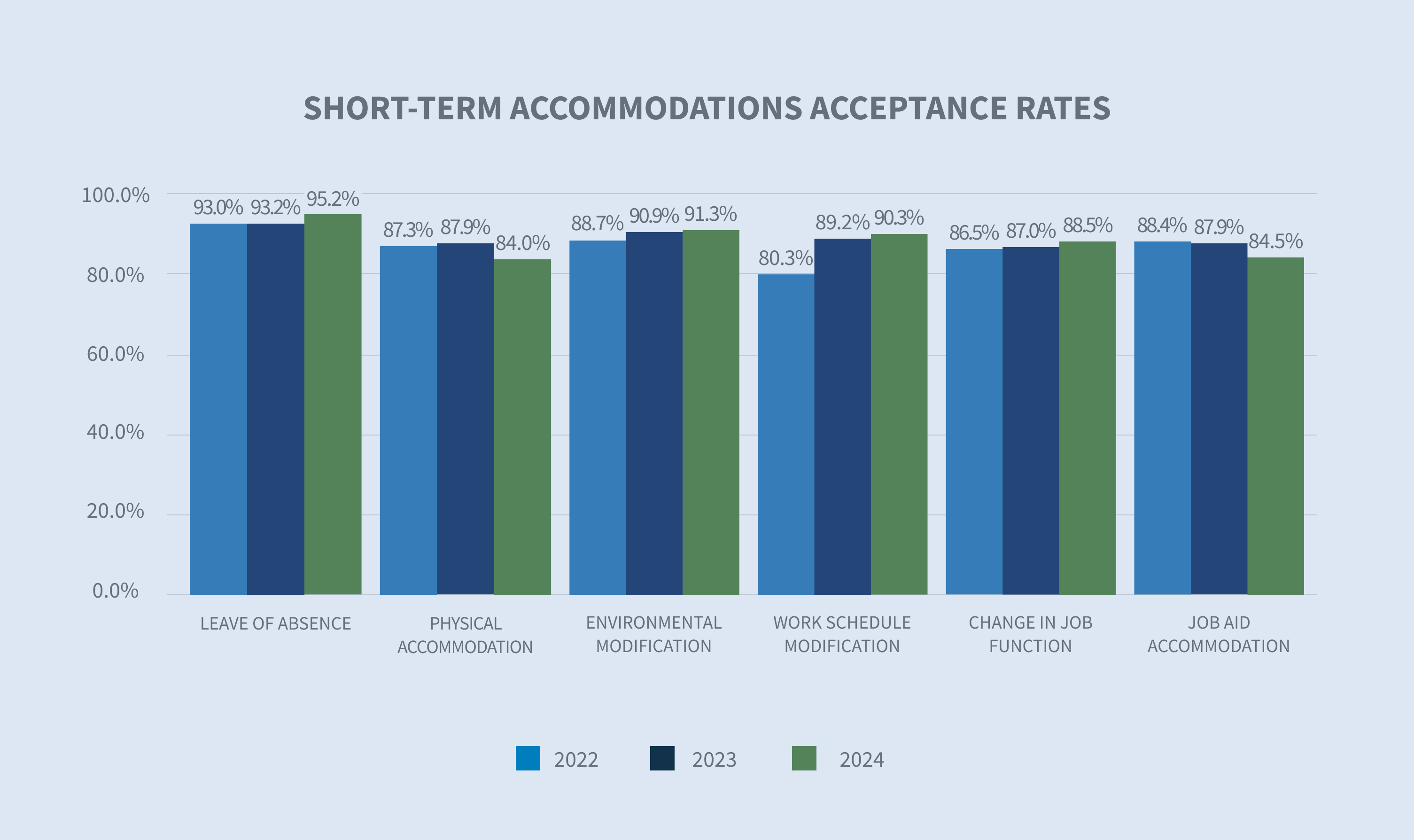
- Summer 2024: BENEFITS
Accommodations
Report objectives
This report aims to summarize the present metrics for our accommodation programs, assess the landscape of accommodation and Americans with Disabilities Act (ADA) claim administration and litigation, and benchmark our patterns against comparable industry research.
data parameters
Our practice team uses TAMS claims data to perform comparative analyses informed by their expertise and analytics. The data in this report is based on the first half of each year, January through June, for each reporting year.
Key observations
Post-COVID, accommodation rates have shown more consistent and stable volumes from 2022 onwards. From 2023 to 2024, there was an increase of 1.3%, with incident rates rising from 2.61 to 2.93, marking a 12.4% increase in 2024.
In 2024, 65.6% of accommodation requests are for leave only, down from 71.4% in 2023. This decrease may be attributed to the time elapsed since the Great Resignation. Many employees submitting new accommodation requests have been with the company for one to three years, making them eligible for Family and Medical Leave Act (FMLA) and/or state leaves rather than needing an accommodation leave. Meanwhile, at work accommodations have increased 22.1%, now accounting for 31.7% in 2024 compared to 26.1% in 2023.

Environmental modifications increased from 6.1% in 2023 to 6.3% in 2024. This growth was anticipated as more companies mandate a return to the office, prompting employees to request accommodations to work from home.
Intermittent leave of absence increased from 17.3 days per request in 2023 to 17.8 days in 2024. Meanwhile, continuous leave of absence decreased from 82.2 days in 2023 to 80.6 days in 2024.
Accommodations are granted at a very high rate. Although there was a slight decrease in 2022, the trend has been shifting upward in 2023 and 2024. In 2024, 94.8% of accommodations were granted, up from 92% in 2023, a 3% increase. This rise in accommodation requests, both for leave of absence and at work, can be attributed to employees becoming more educated on the necessary medical requirements.
New volumes
The accommodation incident rate slightly decreased from 2022 to 2023 but showed a 12.3% increase from 2023 to 2024.

There are significant shifts by industry, with retail volumes and incident rates increasing, a trend also observed in transportation, manufacturing, financial and services industries.

Accommodation requests by type
Over the past three years, we have observed a significant shift in the types of accommodation requests. In 2020, 39% of requests were for at work accommodations, while 57% were for leave of absence. At work accommodations decreased in 2021 and 2022 but began to rise again by 2023. In 2024, at work accommodations account for 32% of requests, while leave accommodations have increased to 66%. This can be attributed to more employers requiring hybrid or return-to-office policies in 2024.


Focusing on at work accommodations, we have observed notable shifts over the past three years.
Both work schedule and environmental modifications have been trending downward, with work schedule requests decreasing to 21% in 2024 from 25% in 2023, and environmental modifications dropping from 19% in 2023 to 17% in 2024. Additionally, change in job function requests decreased in 2024. The majority of environmental modifications are requests to work from home.

Granted rate
Accommodation requests continue to be granted at a high rate, with 94.8% being accommodated in 2024. The granted rate increased from 2022 into 2023. This is significant as it means that employers are more willing to grant accommodations than run the potential risk of litigation when dealing with accommodation requests.



The acceptance rate for short-term accommodations mirrors our overall granted rate, remaining high and continuing to increase since 2022. The only exceptions are job aid accommodations and physical accommodations, which both saw a slight decrease of about 3%.

Accommodation durations
The duration of accepted accommodations has varied year over year. Continuous leave of absence (LOA) time has decreased by 1.6%, while intermittent leave time has increased by 0.5%.

For durations by age group for both at work accommodations as well as leave of absence accommodation requests, all age groups except ages 55+ are trending higher in 2024 versus 2023. While the age 55+ group is decreasing, the decrease was not as significant as the increases in other groups.

New accommodations by length of service (LOS)
A shift in the tenure of employees requesting accommodations is being observed. In 2022, 11% of these requests came from employees within their first 12 months of service. This percentage decreased in both 2023 and 2024, with only 8% of requests coming from employees within their first service year in 2024. Given the market realignment that took place in 2021 and 2022, we expect the three to five length of service group to become the leading driver of claims in the next nine to 18 months.

Future considerations
Loper Bright Enterprises v. Raimondo
This recent U.S. Supreme Court case overturned a 40-year precedent set in Chevron v. Natural Defense Resource Council. The initial decision in Chevron held that the courts should defer to the appropriate regulatory agencies when the federal legislation is ambiguous or has a gap. Considering Loper, this means that courts no longer must defer to agency interpretation of grey areas. The greatest impact could be felt by agency rulings from the U.S. Department of Labor (DOL) and Equal Employment Opportunity Commission (EEOC) as it relates to the Family Medical Leave Act (FMLA) and Americans with Disabilities Act (ADA) and most recently the Pregnant Workers Fairness Act (PWFA). Further impacts could be felt at the state level if challenges are made to the regulatory interpretation of statutory Paid Family and Medical Leave (PFML) benefit programs at the state level.

Working from home
Before the pandemic, the consensus in the courts was that it was at the employer’s discretion to decide if physical presence in the office was an essential function of most jobs and if remote work was not a reasonable accommodation. Now, the interactive dialogue is paramount. After two years of teleworking, there will be questions about why employees with a disability cannot continue to work remotely as an accommodation. To justify hardship, an employer should be prepared to prove that although remote work was required during the shutdown, it was not effective (e.g., problems with technology, decreased productivity, lost sales, etc.).

The EEOC recently announced that it settled its first case related to an ADA accommodation related to COVID, and it involved work from home. Specifically, ISS Facility Services, Inc., a workplace experience and facility management company, will pay $47,500 and provide other relief to settle a disability discrimination and retaliation lawsuit. The lawsuit alleged that an employee at ISS requested an accommodation to work remotely two days per week and be allowed frequent breaks while working on-site due to her pulmonary condition, which placed her at a greater risk of contracting COVID. Although ISS allowed other employees in her position to work from home, it denied her request and terminated her employment. While the agency’s announcement does not detail whether ISS engaged in a robust interactive dialogue, the events lead to a reasonable conclusion that ISS did not.
Litigation trends
In FY 2023, the EEOC filed 48 disability-related lawsuits, up from 27 in FY 2022. Nine of the cases dealt with hearing-related disabilities. Several of the suits dealt with failure to accommodate mental health impairments. We also saw the agency file its first two lawsuits for religious discrimination based on the U.S. Supreme Court ruling last year in Groff v. DeJoy.
We expect to see the uptick continue because the U.S. Senate approved a new commissioner in 2023, which gives Democrats a 3-2 majority on the EEOC board. While there is an election in 2024, we do not anticipate the makeup of the board to change until 2025 or 2026, depending on the outcome of the U.S. Senate elections.
Federal legislation
The PWFA was signed into law by U.S. President Joe Biden on Dec. 23, 2022. The PWFA took effect June 27, 2023, and created obligations for employers of 15 or more related to their pregnant employees who seek accommodations. One of the PWFA’s primary provisions is the obligation for employers to interactively dialogue with pregnant employees who request accommodations (similar to the ADA’s obligation). The EEOC was supposed to release final rules in December 2023 but did not until April 2024.

Among the final rules, the EEOC outlines the rights to accommodations before, during and post-pregnancy, detailing the actions an employee must take to utilize these rights, particularly when they aren’t eligible for leave under company policies, leave laws or if leave is denied due to eligibility, entitlement or documentation issues. Importantly, an employee denied leave for failing to provide adequate documentation (or any documentation) to support an FMLA/state law claim will likely still have accommodation rights under the PWFA and other applicable state pregnancy accommodation laws based on the low documentation support thresholds that apply.
The final rules also noted that absent undue hardship typically must be provided without seeking documentation under the PWFA, such as an accommodation to:
| • | Carry or keep water and drink, as needed, in or nearby their work area. |
| • | Take additional restroom breaks, as needed. |
| • | Stand or sit, and/or vice versa, as needed. |
| • | Take breaks, as needed, to eat and drink. |
| • | Pump (which includes a time/place to pump, or any other modification related to pumping at work). | • | Nurse because their child is in close proximity to their regular place of work. |
The EEOC has noted that they tend to heavily enforce this, so we will see if we start to see court cases by the end of 2024. Several states have already sued the EEOC to halt enforcement of certain provisions under the law and those are currently working their way through the lower courts.
